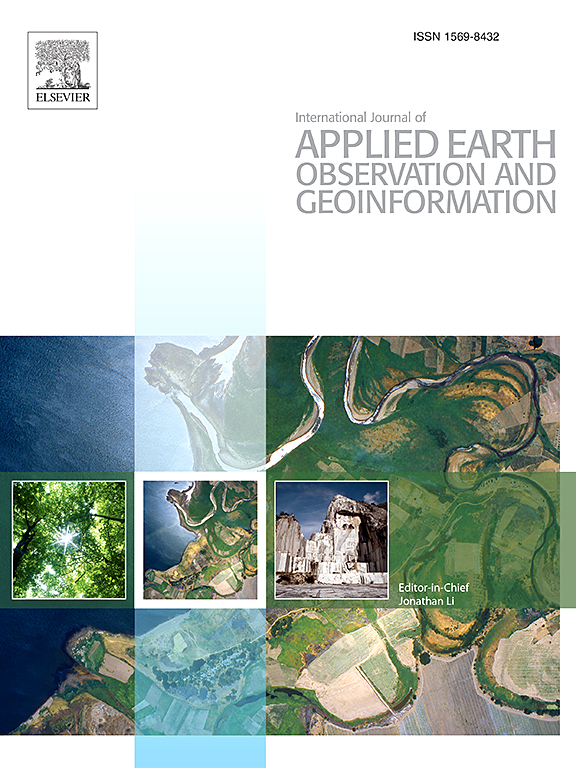基于无人机点云的农田三维语义映射多尺度特征学习
IF 8.6
Q1 REMOTE SENSING
International journal of applied earth observation and geoinformation : ITC journal
Pub Date : 2025-05-29
DOI:10.1016/j.jag.2025.104626
引用次数: 0
摘要
准确的地物空间分布信息是实现农机自主导航的关键。然而,由于光照变化和不同区域之间的相互遮挡,当前的感知系统在复杂的农场环境中表现出有限的分割性能。为支持自主农机路径规划,提出了一种低成本的厘米级农业领域三维语义地图无人机摄影测量框架。该方法将无人机捕获的图像与RTK定位相结合,重建高精度的三维点云,然后采用一种集成多尺度注意机制和几何约束的新颖的局部-全局特征聚合网络(LoGA-Net)。该框架对水田、旱田、建筑、植被、农田轨道、铺装地面、基础设施和其他静态障碍物等8个关键农业类别的分类mIoU达到78.6%。实验验证表明,在Semantic3D基准测试上,与RandLA-Net相比,准确率提高了5.9%。这一进展显著提高了复杂农业环境下的感知精度,特别是在田地边界划定和遮挡特征识别方面,这直接促进了无人驾驶农业机械的鲁棒路径规划。该框架为实现完全自主的农场运营提供了可扩展的技术和数据驱动基础,确保了运营效率和环境可持续性。本文章由计算机程序翻译,如有差异,请以英文原文为准。
Multi-scale feature learning for 3D semantic mapping of agricultural fields using UAV point clouds
Accurate spatial distribution information of field features is critical for enabling autonomous agricultural machinery navigation. However, current perception systems exhibit limited segmentation performance in complex farm environments due to illumination variations and mutual occlusion among various regions. This paper proposes a low-cost UAV photogrammetry framework for centimeter-level 3D semantic maps of agricultural fields to support autonomous agricultural machinery path planning. The methodology combines UAV-captured images with RTK positioning to reconstruct high-precision 3D point clouds, followed by a novel Local-Global Feature Aggregation Network (LoGA-Net) integrating multi-scale attention mechanisms and geometric constraints. The framework achieves 78.6% mIoU in classifying eight critical agricultural categories: paddy field, dry field, building, vegetation, farm track, paved ground, infrastructure and other static obstacles. Experimental validation demonstrates a 5.9% accuracy improvement over RandLA-Net on the Semantic3D benchmark. This advancement significantly enhances perception accuracy in complex agricultural environments, particularly for field boundary delineation and occluded feature recognition, which directly facilitates robust path planning for unmanned agricultural machinery. The framework provides a scalable technical and data-driven foundation for achieving fully autonomous farm operations, ensuring both operational efficiency and environmental sustainability.
求助全文
通过发布文献求助,成功后即可免费获取论文全文。
去求助
来源期刊

International journal of applied earth observation and geoinformation : ITC journal
Global and Planetary Change, Management, Monitoring, Policy and Law, Earth-Surface Processes, Computers in Earth Sciences
CiteScore
12.00
自引率
0.00%
发文量
0
审稿时长
77 days
期刊介绍:
The International Journal of Applied Earth Observation and Geoinformation publishes original papers that utilize earth observation data for natural resource and environmental inventory and management. These data primarily originate from remote sensing platforms, including satellites and aircraft, supplemented by surface and subsurface measurements. Addressing natural resources such as forests, agricultural land, soils, and water, as well as environmental concerns like biodiversity, land degradation, and hazards, the journal explores conceptual and data-driven approaches. It covers geoinformation themes like capturing, databasing, visualization, interpretation, data quality, and spatial uncertainty.
 求助内容:
求助内容: 应助结果提醒方式:
应助结果提醒方式:


